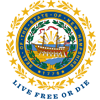Public Water Systems
Monitoring and sampling of community and non-transient, non-community public water systems.
Sampling for PFAS in the state started in 2016 and has been conducted at over 1,400 public water system sources. Based on the sampling results to-date, PFAS has been detected at about 30% of the public water system sources that have been sampled. However, exceedances of PFAS drinking water standards have only occurred at about 7% of those sources.
Since October of 2019, community public water systems and non-transient, non-community public water systems have had to complete sampling for PFOA, PFOS, PFNA and PFHxS for compliance. NHDES publishes a biannual report of the occurrence of PFAS in the state that includes PFAS results for each public water system that has been sampled. Results can also be found on the NHDES PFAS Sampling Dashboard. Lastly, all water quality results (not only PFAS) for all regulated public water systems in the state can be found on NHDES’ Onestop Data Retrieval site.
What Public Water Systems are required to sample for PFAS?
Two of the three types of public water systems in New Hampshire are required to sample for PFAS. They are:
- Community Water Systems – These are public water systems that serve water to residents in their homes and businesses all the time, examples are cities, towns, village districts, large homeowner association or cooperative-owned subdivisions.
- Non-transient, non-community water systems – These are public water systems that routinely serve water to the same population of people but not in their homes and not all of the time, like schools, hospitals, and large business buildings with many permanent employees.
Public water systems that serve a transient population of people, like hotels and restaurants, are not required to sample for PFAS.
How frequently do Public Water Systems need to sample for PFAS?
Initially, when the PFAS standards were established in 2019, public water systems were required to sample for PFAS quarterly for one year. After the first year, the frequency of PFAS sampling at a public water system is based on the average of the four quarters of those initial results as follows:
- Quarterly, if one of the initial results exceeds four times the drinking water standard or the average of the initial quarterly results exceeds the drinking water standard.
- Annually, if the annual average of the quarterly results are greater than 50% of the drinking water standard but do not exceed the standard.
- Once every three years, if the annual average of the quarterly results are less than 50% of the drinking water standard or PFAS is not detected in the sample(s) collected.
Additionally, new public water systems are required to collect quarterly samples for PFAS during their first year of operation, after which their PFAS collection frequency is assigned as described above. In the event that results of PFAS samples collected from a water system exceed the drinking water standards, or the water system puts a treatment system online to remove PFAS from the drinking water, then the PFAS sampling frequency at the water system is reset to quarterly.
Where are PFAS samples collected within the Public Water System?
PFAS samples are collected from each source that provides water to a public water system, specifically at a location in the piping just before water from the source enters into a water system’s water supply mains. In most public water systems, each source has its own “entry point” sample location. If water from multiple sources are combined (mixed) at one location before it enters the water mains at the system, then one entry point sampling location is established for that combined source location.
How are samples for PFAS collected at Public Water Systems?
Public water works staff, or state-certified water system operators and sampling agents are the only parties authorized to collect water quality samples at public water systems for purposes of compliance with water system standards. Given the very low detection limits for PFAS (parts per trillion) and the fact the PFAS compounds are present in many consumer and commercial products and materials, stringent sampling preparation and handling practices must be followed in order to obtain a viable PFAS sample of drinking water from a public water system. NHDES provides public water systems and their operators a Guidance for PFAS Sample Collection, which provides a detailed set of practices and standards to follow when collecting a PFAS sample from the water system and submitting it to a state certified laboratory for analysis.
What happens if PFAS are detected in a Public Water System?
When PFAS are detected at a public water system above the drinking water standard(s), the system must collect a second sample to confirm the results. If confirmed, the system must distribute a public notification alerting its customers of the exceedance of the standard. The system will then have to collect PFAS samples each quarter. Should the annual average of the quarterly samples exceed the PFAS drinking water standard(s), the system will be identified as formally out of compliance and will be required to take action to address the violation.
A public water system that’s out of compliance with PFAS standards may be able to de-activate the source(s) of impacted water and use an alternate source or blend the source water with other sources to reduce PFAS levels. If these remedies are not an option for a water system, then the system must determine a solution to reduce PFAS levels below the applicable drinking water standards.
Rules
Contact Us
NHDES Drinking Water and Groundwater Bureau
General Information:
(603) 271-2513
dwgbinfo@des.nh.gov



